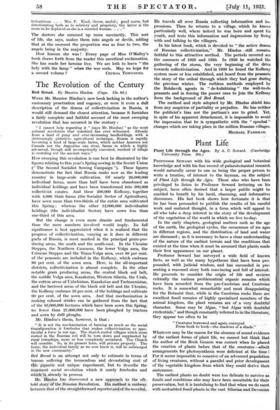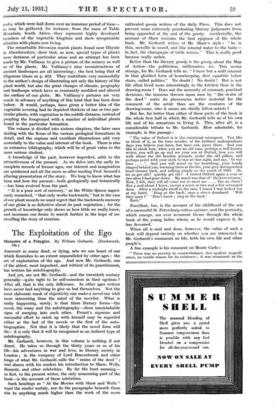Plant Life
PROFESSOR SEWARD with his wide geological and botanical knowledge and with his fine record of palaeobotanical research would naturally occur to one as being the proper person to write a treatise, of interest to the layman, on the subject of Plant Life through the Ages. Those also who have been privileged to listen to Professor Seward lecturing on his subject, have often desired that a larger public might be enabled to benefit by his lucid, charming, and informative discourses. His last book shows how fortunate it is that he has been persuaded to publish the results of his careful work and matured thought, in a form which will appeal to all who take a deep interest in the story of the development of the vegetation of the world in which we live to-day.
In the early chapters, geological matters such as the age of the earth, the geological cycles, the occurrence of ice ages in different regions, and the distribution of land and water are discussed ; as it is necessary to have a clear understanding of the nature of the earliest terrain and the conditions that existed at the time when it must be assumed that plants made their first appearance on .our planet. Professor Seward has surveyed a wide field of known facts, as well as the many hypotheses that have been pro- pounded, with judicial wisdom, and his succeeded in pre- senting a reasoned story both convincing and full of interest. He proceeds to consider the origin of life and reviews critically the various problematical organic remains which' have been recorded from the pre-Cambrian and Cambrian rocks. It is somewhat remarkable and most disappointing for the Botanist that, while in the Cambrian 'rocks there are excellent fossil remains of highly specialized members of the animal kingdom, the plant remains are of a very doubtful character. Some may be Algae, ".but Algae With doubtful credentials," and though constantly referred to in the literature, they appear too often to be "Creatures borrowed and again conveyed From boa to book—the shadows of a shade."
Whatever may be the reason for the absence of sound evidence of the earliest forms of plant life, we cannot but think that the author of the Book Genesis was correct when he placed. the creation of plants before that of the creatures—albeit arrangements for photosynthesis were deficient at the time.! For it seems impossible to conceive of an advanced population Of living creatures, without a parallel and prior development of the vegetable kingdom from which they could derive their sustenance.
The earliest plants no doubt were too delicate to survive as fossils and conditions also may have been unsuitable -for their preservation, but it is tantalising to find that when we do meet with undoubted fossil plants in the vast Silurian and Devonian
rocks, which were laid down over an immense period of time— as- may be gathered, for instance; from the mass of Table Mountain, South Africa—they represent highly developed members of the vegetable kingdom and show recognisable affinities with plants now living.
The remarkable Devonian marsh plants found near Rhynie in Aberdeenshire, show that, as now; special types of plants were denizens of particular areas and an attempt has been made -by Mr. VuRiamy to give a picture of the scenery as well as of the plants. Mr. V-ulliamy's nine reconstructions of ancient landscapes rate all Interesting ; the best being that of Oligoaene limes on p.-452: They contribute very successfully to.the author's design of illustrating not only the history of the plant World, but also the great changes of climate, geography and -landscape which have so Constantly modified and altered the surface of our, globe. Mr. Vulliamy's pictures are very much in advance of anything of this kind that has been done before. -It would, perhaps, have given a better idea of the vegetable covering had he depicted thickets of one or two par- tioular plants, with vegetation in the middle distance, instead of peopling the foreground with a niimber of individual plants found in the -particular formation.
- The volume is divided into sixteen -chapters, the later ones dealing with the floras of the various geological formations in detail, and the copious and excellent illustrations add very materially to the value and interest of the book. There is also an extensive bibliography, which will be of great value to the more serious student.
A knowledge of the past, however imperfect, adds to the attractiveness of the present. As we delve into the sadly in- complete records of former ages, our interest and imagination are quickened and all the more so after reading Prof. Seward's alluring presentation of the story. We long to know what has been and how the present—both geologically and botanically —has been evolved from the past.
"it is a poor sort of memory," as the White Queen sagaci- ously remarked, "that only works backwards," but in the ease of our plant records we must regret that the backwards memory of our globe is so defective about its past vegetation ; for the growth of knowledge only shows us how little we really know, and increases our desire, to search further in the hope of un- ravelling the stciry of creation.



































 Previous page
Previous page